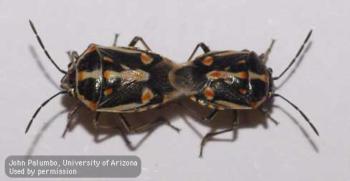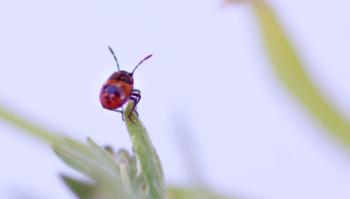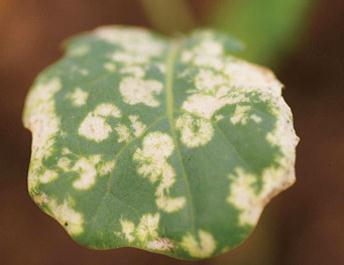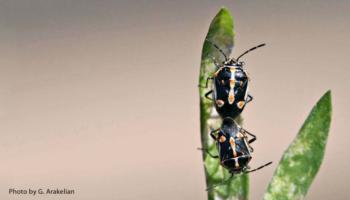Spring 2013: Management of the Bagrada bug in nurseries
Regional Report Ventura and Santa Barbara Counties by Julie Newman
Damage caused by the Bagrada bug resulted in devastating crop losses for Ventura County growers last fall. This plant-feeding stink bug infests wild mustard weeds in the late winter to early spring. Pest populations rapidly increase in the weeds when seasonal temperatures rise. Record numbers of this pest have invaded newly planted cole crops after the weeds dry out in late summer. Additionally, the Bagrada bug has become a major problem in Ventura County nurseries where bedding plants, plugs, and transplants are produced—attacking young vegetable and ornamental plants in the mustard family Brassicaceae (Cruciferae).
The Bagrada bug, also called painted bug (Bagrada hilaris), was first found in the United States in Los Angeles County in 2008. By 2011, the pest had disseminated throughout Southern California including Ventura County. Last September, the pest moved northward to Santa Barbara and San Luis Obispo counties.
Weeds that serve as hosts include cruciferous weeds (e.g., various wild mustards, shepherd’s purse, London rocket and pepperweed), as well as weeds in other plant families (e.g., lambsquarters, purple nutsedge, Euphorbia spp, perennial sowthistle, field bindweed). Globally, the Bagrada bug is a serious pest of cruciferous crops such as cabbage, cauliflower and broccoli. In nurseries, mustard family plants such as alyssum, stock, candytuft, rockcress and wallflower can be infested. Although mustard family plants are the primary hosts, the Bagrada bug also causes feeding damage on cultivated plants in other plant families. When preferred hosts are unavailable, the bug will attack plants that are not reproductive hosts and may or may not cause feeding damage. For example, large numbers of Bagrada bugs have been found in Ventura County on strawberry crops, although feeding damage has not been reported.
The Bagrada bug currently has a B rating by CDFA. Strict monitoring of outbound plants is required to prevent pest spread through the movement of plant material. Since the Bagrada bug can be found incidentally on a broad range of plant species, extensive crop monitoring for this pest in nurseries is necessary.
Identification and Biology
Adults are black with orange and white markings; the shield-shaped body is about ¼-inch (5-7 mm) long and about half as wide at the broadest part (fig. 1A). Eggs are barrel shaped and initially white but eventually turn orange. Females lay eggs in the soil beneath host plants, but may also oviposit on leaves or on hairy stems of non-host plants. Additionally, eggs are often laid on plant protective coverings such as mesh screens. Depending on temperature, a female bug can lay up to 150 eggs within two to three weeks that can hatch in four days.The nymph passes through five instars (fig. 1B). Newly emerged nymphs of all stages are orange-red but legs, head and thorax darken quickly. Older nymphs develop wingpads prior to becoming adults.
In Southern California there are multiple generations each year and populations generally peak late in summer and fall. Usually all life stages are present together on plants. Development is favored by warmer temperatures; the adults tend to fly when temperatures are above 85oF.
 |
 |
| A | B |
Fig. 1. (A) Adult Bagrada bugs are black with orange and white markings and are commonly found mating, positioned end-to-end. Note that the female (left) is longer than the male (right). Photo by John Palumbo, University of Arizona, courtesy of UC IPM. (B) Bagrada bug nymph resembles an adult ladybird beetle, with similar bright coloration. Photo by Mike Lewis, courtesy of the Center for Invasive Species Research, UC Riverside.
Plant Damage
Adults and nymphs of the Bagrada bug feed on leaves, stems, flowers and seeds. They insert their needle-like mouth parts into young leaves and suck out sap, resulting in starburst-shaped lesions (fig. 2). Leaves eventually have large stippled areas and may wilt and die. Ultimately damage results in “scorched” leaves, stunting, blind terminals, and forked or multiple heads on cauliflower, broccoli and cabbage. Bagrada bugs are particularly damaging to small plants and may kill seedlings.
 |
 |
| A | B |
Fig. 2. (A) Typical fresh feeding damage appears light green with starburst lesions and then bleaches with age, giving leaves a “scorched” appearance when feeding is heavy. Photo by John Palumbo, University of Arizona, courtesy of USDA-NIFA Regional IPM Centers; (B) Multiple stages of Bagrada bug adults and nymphs (not shown) have caused large white stippled areas on alyssum. Photo by G. Arakelian, Los Angeles County Agriculture Commissioner.
Management
Monitoring. Early detection is important because populations can build up quickly. All plants should be regularly inspected, especially in-coming and out-going plant shipments and all host crops/weeds. More frequent monitoring may be necessary when temperatures rise above 75oF. When temperatures are low or extremely hot, these bugs may hide on the undersides of leaves, around stem bases, or in moist soil cracks and crevices. Bagrada bugs may not be readily observed until damage has begun. Look carefully for fresh feeding damage (light green starburst lesions), which may be easier to spot than the insects themselves. A good time to inspect is right after irrigating when pests hiding in the space between the potting mix and the sides of the container may be flushed out and more easily detected. When the bugs are common, they may be monitored by beating or by shaking plants over a tray or a sheet of paper.
Cultural control. Remove weed hosts in and near production areas. Bagrada bug adults, eggs and nymphs in the soil or container media can be controlled by steam or chemical treatment before planting. When bugs are abundant, isolate crucifers in a separate area in the nursery. Removal of crop residue after harvest can reduce carry-over between crops.
Mechanical control. Picking the bugs off plants by hand is only feasible if pest populations are very low. When infestations are heavy, it may be possible to vacuum the bugs. Using wild hosts as trap crops should be conducted carefully because the trap crop could also serve as a source of infestation for nursery plants. Growers with access to greenhouses can protect cruciferous bedding plants and vegetable plugs by producing them inside. Using a double-door system in greenhouses can help to exclude the bugs, and screened vents prevent entry of flying adults. As an alternative to greenhouses, screened tunnels or floating row cover fabric can provide plant protection. The mesh of the screening material must be fine enough to exclude the Bagrada bug nymphs and should be elevated so that it does not touch the plants because the bugs can feed through these coverings. The edges of protective covers must also be buried to prevent the bugs from crawling underneath to the plants.
Chemical control. There is little information on chemical control of the Bagrada bug in nurseries. Generally, stink bugs are difficult to manage with insecticides, and repeat applications are often necessary. Research on managing this pest on cole crops suggest that synthetic pyrethroids, neonicotinoids and organophosphate compounds may be effective in minimizing the damage, although the adult bugs may fly away before they are contacted only to return later. There are no effective chemical options for organic production although insecticidal soap and horticultural oils, including neem oil and paraffinic oil, may provide some control against the nymphs. Check the pesticide label to make sure the product is registered for use on nursery crops. Rotating chemicals with different modes of action is important to minimize potential resistance problems.
More Information
See Jim Bethke’s “Field Observations” in this newsletter. Additionaly, a detailed handout on the Bagrada bug was prepared for the UCNFA “BMP Programs for California Nurseries” meeting held in Ventura on March 20. The handout contains a list of registered pesticides, compiled by Jim Bethke, along with a list of references. If you would like a copy, please visit my website at http://ceventura.ucanr.edu/Environmental_Horticulture/Nursery/.
Julie P Newman
Floriculture and Nursery Crops Advisor
UC Cooperative Extension Ventura County
669 County Square Drive, #100
Ventura, CA 93003-5401
(805) 645-1459 phone, (805) 645-1474 fax
jpnewman@ucdavis.edu












